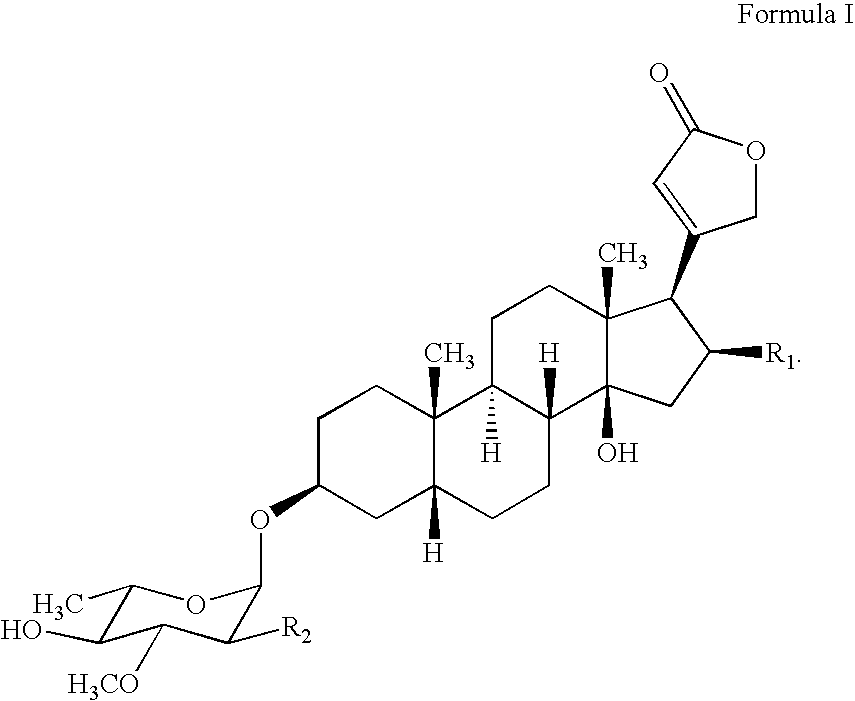Water soluble formulations of digitalis glycosides for treating cell-proliferative and other diseases
a technology of digitalis glycoside and glycoside, which is applied in the field of medicine and pharmacology, can solve the problems of oleander plant certain toxic properties, unable to restore normal levels during diastole, and giving ris
- Summary
- Abstract
- Description
- Claims
- Application Information
AI Technical Summary
Benefits of technology
Problems solved by technology
Method used
Image
Examples
example 1
Preparation of Oleandrin-Cyclodextrin Formulation
[0104] 10 milligrams (mg) of oleandrin was stirred and shaken with 10 ml of water in a test tube. Appreciable quantities of compound remained out of solution after 20 minutes accumulating as white crystals at the bottom of the test tube.
[0105] 100 milligrams of oleandrin was weighed and placed in a 5 mL scintillation tube. 1.5 mL of absolute ethanol was added to the tube and shaken until the oleandrin was completely dissolved. 5 grams of pyrogen free hydroxypropyl-β-cyclodextrin (sold by, Sigma-Aldrich, Inc., St. Louis, Mo., USA) was weighed on an analytical scale and placed in a graduated cylinder. Water was added with shaking until the volume reached 90 ml. The above ethanolic solution of oleandrin was added to the aqueous solution containing hydroxypropyl-β-cyclodextrin with stirring. A clear solution was obtained. Water was added to the clear solution to make the total volume to 100 mL. Thus, 1 mg oleandrin was effectively solub...
example 2
Preparation of Oleandrin-Cyclodextrin Formulation
[0106] The previous experiment was repeated using a 2% solution of hydroxypropyl-β-cyclodextrin prepared as in Example 1. 100 mg of oleandrin was dissolved in 100 mL of water containing 2.5 grams of hydroxypropyl-β-cyclodextrin. The solution was sterile-filtered through a 0.22 μm filter. The solution was frozen below −40° C. and lyophilized. The lyophilized cake was reconstituted with sterile water for injection prior to further use.
example 3
Preparation of Odoroside-A-Cyclodextrin Formulation
[0107] The experiment in example 1 was repeated using a 100 mg of Odoroside-A instead of oleandrin. 100 mg of Odoroside-A was dissolved in 5 grams of hydroxypropyl-β-cyclodextrin in 100 mL of water. The solution was sterile-filtered through a 0.22 μm filter. The solution was frozen below −40° C. and lyophilized. The lyophilized cake was reconstituted with sterile water for injection prior to further use.
PUM
| Property | Measurement | Unit |
|---|---|---|
| Concentration | aaaaa | aaaaa |
| Concentration | aaaaa | aaaaa |
| Concentration | aaaaa | aaaaa |
Abstract
Description
Claims
Application Information
 Login to View More
Login to View More - R&D
- Intellectual Property
- Life Sciences
- Materials
- Tech Scout
- Unparalleled Data Quality
- Higher Quality Content
- 60% Fewer Hallucinations
Browse by: Latest US Patents, China's latest patents, Technical Efficacy Thesaurus, Application Domain, Technology Topic, Popular Technical Reports.
© 2025 PatSnap. All rights reserved.Legal|Privacy policy|Modern Slavery Act Transparency Statement|Sitemap|About US| Contact US: help@patsnap.com


